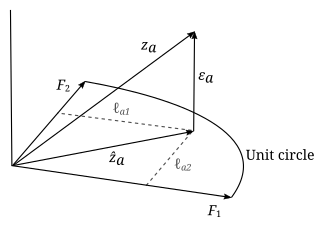Factor analysis
Statistical method used to describe variability among observed variables
Overview[edit]

Factor analysis is a statistical method used to describe variability among observed, correlated variables in terms of a potentially lower number of unobserved variables called factors. The observed variables are modeled as linear combinations of the potential factors, plus "error" terms. The information gained about the interdependencies can be used later to reduce the set of variables in a dataset.
History[edit]
Factor analysis originated in psychometrics and is used in behavioral sciences, social sciences, marketing, product management, operations research, and other applied sciences that deal with large quantities of data. The method was first introduced by Charles Spearman in the early 20th century.
Types of Factor Analysis[edit]
There are two main types of factor analysis:
- Exploratory Factor Analysis (EFA): Used to identify the underlying relationship between measured variables. It is often used when the researcher does not have a preconceived idea of the structure or number of factors.
- Confirmatory Factor Analysis (CFA): Used to test the hypothesis that the relationships between observed variables and their underlying latent constructs exist. It is often used when the researcher has a specific idea about the structure or number of factors.
Applications[edit]
Factor analysis is widely used in various fields:
- In psychology, it is used to identify latent constructs such as intelligence, personality traits, and other psychological phenomena.
- In marketing, it helps in identifying underlying factors that affect consumer behavior and preferences.
- In finance, it is used to identify factors that affect stock prices and market trends.
Methodology[edit]
The process of factor analysis involves several steps:
1. Data Collection: Gather data on the variables of interest. 2. Correlation Matrix: Compute the correlation matrix of the variables. 3. Extraction of Factors: Use methods such as principal component analysis or maximum likelihood to extract factors. 4. Rotation: Apply rotation methods like varimax or promax to achieve a simpler and more interpretable factor structure. 5. Interpretation: Analyze the factor loadings to interpret the factors.
Limitations[edit]
Factor analysis has several limitations:
- It requires a large sample size to produce reliable results.
- The results can be sensitive to the method of extraction and rotation used.
- It assumes linear relationships between variables and factors.
Related pages[edit]
Ad. Transform your life with W8MD's Budget GLP-1 injections from $75


W8MD offers a medical weight loss program to lose weight in Philadelphia. Our physician-supervised medical weight loss provides:
- Weight loss injections in NYC (generic and brand names):
- Zepbound / Mounjaro, Wegovy / Ozempic, Saxenda
- Most insurances accepted or discounted self-pay rates. We will obtain insurance prior authorizations if needed.
- Generic GLP1 weight loss injections from $75 for the starting dose.
- Also offer prescription weight loss medications including Phentermine, Qsymia, Diethylpropion, Contrave etc.
NYC weight loss doctor appointmentsNYC weight loss doctor appointments
Start your NYC weight loss journey today at our NYC medical weight loss and Philadelphia medical weight loss clinics.
- Call 718-946-5500 to lose weight in NYC or for medical weight loss in Philadelphia 215-676-2334.
- Tags:NYC medical weight loss, Philadelphia lose weight Zepbound NYC, Budget GLP1 weight loss injections, Wegovy Philadelphia, Wegovy NYC, Philadelphia medical weight loss, Brookly weight loss and Wegovy NYC
|
WikiMD's Wellness Encyclopedia |
| Let Food Be Thy Medicine Medicine Thy Food - Hippocrates |
Medical Disclaimer: WikiMD is not a substitute for professional medical advice. The information on WikiMD is provided as an information resource only, may be incorrect, outdated or misleading, and is not to be used or relied on for any diagnostic or treatment purposes. Please consult your health care provider before making any healthcare decisions or for guidance about a specific medical condition. WikiMD expressly disclaims responsibility, and shall have no liability, for any damages, loss, injury, or liability whatsoever suffered as a result of your reliance on the information contained in this site. By visiting this site you agree to the foregoing terms and conditions, which may from time to time be changed or supplemented by WikiMD. If you do not agree to the foregoing terms and conditions, you should not enter or use this site. See full disclaimer.
Credits:Most images are courtesy of Wikimedia commons, and templates, categories Wikipedia, licensed under CC BY SA or similar.
Translate this page: - East Asian
中文,
日本,
한국어,
South Asian
हिन्दी,
தமிழ்,
తెలుగు,
Urdu,
ಕನ್ನಡ,
Southeast Asian
Indonesian,
Vietnamese,
Thai,
မြန်မာဘာသာ,
বাংলা
European
español,
Deutsch,
français,
Greek,
português do Brasil,
polski,
română,
русский,
Nederlands,
norsk,
svenska,
suomi,
Italian
Middle Eastern & African
عربى,
Turkish,
Persian,
Hebrew,
Afrikaans,
isiZulu,
Kiswahili,
Other
Bulgarian,
Hungarian,
Czech,
Swedish,
മലയാളം,
मराठी,
ਪੰਜਾਬੀ,
ગુજરાતી,
Portuguese,
Ukrainian